Does the phrase “Picky Eaters” make your heart sink? You're not alone! For many parents, mealtimes can be a challenge. But why do kids become picky eaters in the first place? And what can you do to help them develop healthy eating habits and foster an enjoyable mealtime experience for everyone involved? Let's take a closer look at why kids become picky eaters—and the power struggles that often ensue.
Why Do Kids Become Picky Eaters?
The truth is that picky eating is a normal part of childhood development. In fact, research has shown that children are born with natural food preferences and even dislikes, which can lead to picky eating. Children need time to get used to new foods and flavors, so don't expect them to love every single thing they try on the first attempt. Kids also tend to be more sensitive than adults when it comes to texture, smell, and taste; so if something looks or tastes strange to them, they may reject it immediately without giving it a chance. That said, some children may be more prone to pickiness than others due to sensory sensitivities or other factors beyond their control.
The Picky Eater Power Struggle
When kids are being selective about what they eat, it can lead to frustration on both sides—which often leads to a power struggle between parent and child over food choices. Unfortunately, this type of power struggle can backfire if not handled correctly; when push comes to shove (literally!), kids are likely to dig their heels in even further rather than give in. It’s important as parents that we remember that our children need us more than anything else in this world—including food! We must strive for balance by setting reasonable boundaries while at the same time allowing our children space and freedom within those boundaries so they feel respected and heard.
How Can I Help My Child Develop Healthy Eating Habits?
Fortunately there are some practical strategies you can use when dealing with a picky eater at mealtime: First of all, don't pressure your child into trying new foods; instead provide plenty of positive reinforcement for trying new things (even if only one bite!). Secondly, make sure meals are fun by including creative dishes or letting your child help out with meal prep; this will help introduce variety into their diet without making them feel overwhelmed or resistant. Finally, stay consistent by offering nutritious options at each mealtime (even if your child refuses them); this will ensure that your child is getting all the essential nutrients he/she needs even if they don't seem interested in eating them right away.
No matter how finicky your little one may be about what they put on their plate, you have the power as a parent—with patience and understanding—to turn mealtimes into enjoyable experiences for everyone involved! By being aware of why kids become picky eaters in the first place and learning how we can best support our children through these developmental stages we can help foster healthy eating habits while avoiding unnecessary power struggles over food choices along the way!
My blogs contain some affiliate links.
Any purchase made is a blessing to my family at no extra cost to you!
Thank you for supporting us!


Halloween is a time for fun costumes, spooky decorations, and, of course, an endless supply of candy. But while kids (and adults) enjoy indulging in sugary treats, few realize the toll it can take on their health—especially the immune system. Every year, hospitals and clinics report a noticeable uptick in illnesses immediately after Halloween. Could all that sugar be partially to blame? (See below for ideas of things to hand out instead of candy and some midnight reading.)
The Science Behind Sugar and Immune Suppression
When you consume sugar, particularly in large amounts, it doesn’t just provide empty calories. It actually has the power to impact immune function. Research has shown that sugar can significantly lower the body’s ability to fight off infections by:
- Weakening White Blood Cells: Sugar can reduce the effectiveness of white blood cells, which are critical for immune defense, for several hours after consumption.
- Increasing Inflammation: Sugar is a known inflammatory agent, and chronic inflammation weakens the immune system’s ability to fend off new infections.
- Reducing Antioxidants: High sugar intake can reduce the body’s antioxidant levels, which play a key role in preventing cellular damage and supporting immune health.
Halloween’s Sugar Binge and Its Impact on Health
During Halloween, sugar consumption skyrockets. Children can consume upwards of 3 cups of sugar—nearly 20 times the daily recommended amount for children—over Halloween night. For adults, the average can be just as high due to all the leftover treats and seasonal sweets like Halloween-themed desserts.
Excessive sugar consumption will:
- Suppress the immune response for hours, potentially leaving the body vulnerable to viruses and bacteria during that critical post-Halloween period.
- Cause blood sugar spikes, which leads to fatigue, mood swings, and compromised immune defense.
- Feed harmful gut bacteria, disturbing the balance in the gut microbiome, which is linked to a weakened immune response.
Statistics: The Spike in Illness After Halloween
Health data shows a significant rise in infections in early November, just after Halloween. Doctors report seeing a wave of patients with common illnesses such as colds, flu, and respiratory infections. This pattern suggests a possible link between the Halloween sugar spike and the immune system’s weakened ability to ward off seasonal viruses. This trend indicates that preventive measures, such as moderating sugar intake, eating healthfully, and practicing good hygiene, are critical in mitigating the spread of these illnesses (CDC, 2023)
Why November Sees More Illnesses
In addition to Halloween sugar overload, other factors compound the problem, such as:
- Colder Weather: Many regions experience cooler temperatures. When the body is expending energy to keep warm, it has less energy to fight off germs.
- Increased Exposure: School activities, fall sports, and family gatherings increase contact with others, making it easier for germs to spread.
- Seasonal Stress: Early November often brings the beginning of holiday stress, which can further suppress immune function, making the body more susceptible to illness.
The cold weather and Increased exposure can be factors in September and October, yet the spike starts November - hmmm.
How to Counteract Halloween's Sugar Effects
If you’re looking to enjoy Halloween treats without the immune-related consequences, consider these tips:
- Set Limits on Candy Consumption: Allow kids (and yourself) to enjoy a few treats on Halloween but store or donate excess candy to avoid prolonged sugar intake.
- Focus on Nutrient-Rich Meals: Ensure that you’re eating well-balanced meals high in vitamins, minerals, and protein, which support immune health.
- Hydrate and Exercise: Staying hydrated helps flush out toxins, and regular exercise has immune-boosting effects.
- Support Gut Health: Add probiotic-rich foods like yogurt or kefir, and fiber-rich foods to keep the gut microbiome healthy, as it plays a major role in immunity.
- Incorporate Immune-Boosting Supplements: Consider vitamin C, zinc, and probiotics to support immune health during this time.
Halloween is a fun and festive time, but it’s essential to be mindful of how a sugar overload can impact health. By moderating sugar intake and supporting your immune system with nutrient-dense foods and healthy habits, you can reduce the likelihood of falling ill in November. This year, treat yourself and your family to a healthier Halloween, and give your immune system a fighting chance for the season ahead. Here are some ideas to give out instead of candy!
Need some midnight reading to send shivers down your spine? How about some studies!
The relationship between sugar consumption and immune suppression has been studied extensively, with research showing that high sugar intake can negatively impact immune function. Here are a few key studies that highlight sugar's immune-suppressing effects:
1. Nieman, D. C., et al. (1993). This study demonstrated that consuming a high dose of glucose could suppress immune cell activity in humans, particularly the neutrophils responsible for defending against infections. They found that sugar intake decreased the ability of these immune cells to attack and neutralize harmful pathogens for several hours after consumption.
Citation: Nieman, D. C., Henson, D. A., Gusewitch, G., Warren, B. J., Dotson, R. C., Butterworth, D. E., & Nehlsen-Cannarella, S. L. (1993). Physical activity and immune function in elderly women. *Medicine and Science in Sports and Exercise*, 25(7), 823-831.
2. Sanchez, A., et al. (1973). In one of the earliest studies linking sugar intake to immune function, researchers found that consuming 100 grams of sugar reduced the efficiency of white blood cells (specifically neutrophils) by up to 50% for several hours. The study found that while vitamin C can help boost immune function, sugar has the opposite effect.
Citation: Sanchez, A., Reeser, J. L., Lau, H. S., Yahiku, P. Y., Willard, R. E., McMillan, P. J., & Magie, A. R. (1973). Role of sugars in human neutrophilic phagocytosis. *American Journal of Clinical Nutrition*, 26(11), 1180-1184.
3. Berthoud, H. R., & Morrison, C. D. (2008). This study examined the impact of high-sugar and high-fat diets on immune function, showing that diets high in sugar and refined carbohydrates lead to low-grade, chronic inflammation, which weakens the body’s immune defenses over time. This long-term inflammation can reduce immune cell efficiency and promote insulin resistance.
Citation: Berthoud, H. R., & Morrison, C. D. (2008). The brain, appetite, and obesity. *Annual Review of Psychology*, 59, 55-92.
4. Calder, P. C., et al. (2011). This review outlines how diets high in refined sugars can disrupt the immune system by causing spikes in blood sugar that induce oxidative stress, inflammatory responses, and changes in white blood cell function. These effects are particularly pronounced in cases of high glycemic index foods, which lead to higher and faster glucose spikes.
Citation: Calder, P. C., Albers, R., Antoine, J. M., Blum, S., Bourdet-Sicard, R., Ferns, G. A., ... & Zhao, J. (2011). Inflammatory disease processes and interactions with nutrition. *British Journal of Nutrition*, 105(S1), S1-S45.
These studies collectively provide evidence that high sugar intake can impair immune function by reducing the effectiveness of immune cells, increasing inflammation, and promoting oxidative stress.
My blogs contain some affiliate links.
Any purchase made is a blessing to my family at no extra cost to you!
Thank you for supporting us!


Halloween is synonymous with candy, but many parents are looking for alternatives that are fun, affordable, and just as exciting for kids. Handing out non-candy items can be a unique and healthier twist that sets your house apart as the “cool house” on the block. Here are five inexpensive, kid-approved, and easily found online to consider handing out this Halloween.
Kids love things that glow, especially on Halloween night!
Glow stick bracelets are a hit with kids of all ages and make an excellent alternative to candy. Not only are they fun, but they’re also practical for trick-or-treating safety, as they make kids more visible at night. These come in packs of 50-100 and are usually under $15, making them affordable for even a large crowd of trick-or-treaters. Look for packs of multicolored glow stick bracelets that come with connectors for easy wear.
2. Halloween-Themed Stickers or Temporary Tattoos
Creative fun that kids can take home and use later!
Halloween-themed stickers or temporary tattoos are inexpensive and a big hit for kids. You can find packs with dozens of designs, featuring ghosts, pumpkins, bats, and more spooky fun. They’re perfect for kids to share with friends or use in arts and crafts after Halloween. Plus, parents will appreciate a non-candy option that sparks creativity. Look for Halloween sticker or tattoo packs that come with a variety of designs. Many options have 100+ pieces for around $10.
Keep the Halloween fun going even after trick-or-treating ends!
Mini Halloween-themed activity books, filled with coloring pages, word searches, or puzzles, make an engaging treat that kids can enjoy at home. These are particularly great for younger kids who love coloring and solving puzzles. Many packs offer multiple designs, so you can hand out different books to different kids. Look for sets of mini activity books with around 24-30 books per pack, often priced under $15.
4. Halloween Erasers or Mini Figurines
A fun, themed item they can use at school or play with at home!
Halloween-themed erasers or mini figurines make fun, practical, and affordable handouts. You can find assortments of erasers shaped like pumpkins, ghosts, and witches. Kids love collecting them and showing them off to friends, and they’re an easy addition to pencil cases or play collections. Search for Halloween erasers in bulk packs (50+), usually around $10-$12, or mini figurine assortments if you want a slightly different option.
5. Bubble Wands
Who doesn’t love bubbles? They’re a timeless favorite!
Bubble wands are always a hit with kids and make a festive Halloween treat they can enjoy outside. Mini bubble wands come in various colors and are small enough to hand out individually. Many kids will start blowing bubbles right on the spot, adding to the fun and excitement of Halloween night. Look for mini bubble wands in sets of 24-30, often under $12. Some come in Halloween-themed packaging, adding to the holiday spirit.
Handing out non-candy treats is a fun way to mix things up and give kids something memorable this Halloween. From glow sticks to activity books, these items are inexpensive, easy to find on Amazon, and guaranteed to bring smiles to trick-or-treaters. This year, try a few non-candy treats, and watch how excited the kids get for these unique goodies!
My blogs contain some affiliate links.
Any purchase made is a blessing to my family at no extra cost to you!
Thank you for supporting us!


Are you struggling to get your child to sit still and pay attention? It’s a common challenge, especially in today’s fast-paced world. But don't worry, there are natural ways to help improve their concentration and focus. This guide will empower holistic moms and families dedicated to wellness with practical tips and strategies to enhance their child's ability to concentrate. By the end of this post, you'll have a toolbox of solutions that promote a balanced and healthy lifestyle.
The Importance of a Balanced Diet and Proper Hydration
Nutrition
What your child eats plays a significant role in their ability to focus. A diet rich in whole foods provides the essential nutrients their brain needs to function optimally.
- Fruits and Vegetables: These are packed with vitamins and minerals crucial for cognitive function. Leafy greens like spinach and kale are particularly beneficial.
- Whole Grains: Foods like oatmeal and quinoa offer a steady release of energy, helping to maintain focus throughout the day.
- Protein: Beans and nuts are excellent sources of protein, which is vital for brain health and neurotransmitter function.
- Healthy Fats: Found in fish, avocados, and nuts, these fats support brain development and function.
Hydration
Even mild dehydration can impact your child’s concentration. Ensure your child drinks plenty of water throughout the day. A general guideline is eight 8-ounce glasses of water daily, but this can vary based on activity level and climate.
- Ensure they have their favorite water bottle ready to go when you are going out.
- Make drinking fun with fruit and vegetable infused water.
- Encourage drinking water instead of sugar-filled drinks, or artificially flavored or colored drinks.
The Power of Regular Physical Activity
Exercise
Incorporating regular physical activity into your child's routine can significantly boost their focus and overall brain function.
- Aerobic Activities: Activities like running, swimming, and cycling not only improve physical health but also enhance cognitive function.
- Team Sports: Engaging in sports like soccer or basketball helps develop social skills and encourages teamwork, which can further aid concentration.
- Yoga and Mindfulness: These practices teach children how to focus and relax, providing lifelong tools for managing stress and maintaining concentration.
Encouraging Play
Ensure your child gets at least an hour of physical activity daily. This can be a mix of structured activities like sports and unstructured play, which is just as important for their development. Sitting for TV or video games should not exceed a 1/2 hour to an hour depending on age before encouraging them to get up and move again.
The Benefits of a Structured Routine and Breaks
Consistent Schedule
Children thrive on routine. A predictable daily schedule helps them know what to expect and when to focus on specific tasks.
- Morning Routine: Start the day with a healthy breakfast and some light physical activity to wake up their bodies and minds.
- Homework Time: Set a consistent time each day for schoolwork, so your child knows when it's time to concentrate.
- Bedtime Ritual: A calming bedtime routine ensures they get enough sleep, which is essential for focus and overall health.
Breaks
Short, frequent breaks help prevent burnout and maintain high levels of focus. The Pomodoro Technique, which involves 25 minutes of focused work followed by a 5-minute break, can be adapted for children. This method keeps their mind fresh and engaged.
How to Minimize Distractions
Environment
Creating a distraction-free environment is crucial for helping your child concentrate.
- Quiet Space: Designate a quiet area for homework and focused activities. Ensure it is well-lit and comfortable.
- Limited Screen Time: Reduce exposure to screens during homework time. Encourage screen-free periods to minimize distractions from phones, TVs, and tablets.
- Organized Space: Keep their study area tidy and free of clutter. An organized space promotes a clear mind.
Creating a Focus-Friendly Zone
Designate a specific area in your home for focused activities. This can be a corner of a room with a desk and necessary supplies, free from distractions.
The Role of Mindfulness and Relaxation Techniques
Mindfulness Activities
Teaching your child mindfulness can significantly enhance their focus and reduce stress.
- Breathing Exercises: Simple breathing exercises can help calm their minds and improve concentration. Try deep breathing before starting homework.
- Mindfulness Games: Engage your child in games that require focus, such as puzzles or memory games. These activities enhance their attention span in a fun way.
- Guided Imagery: Visualization techniques where children imagine peaceful and focused scenarios can help improve their concentration.
Family Relaxation Time
Introduce simple mindfulness practices that can be done together as a family, such as prayer and deep breathing exercises before bedtime. This not only benefits your child but also strengthens family bonds.
Incorporating Essential Oils for Enhanced Focus
Benefits of Essential Oils
Essential oils can be a great addition to your focus-enhancing toolkit. Certain oils are known for their calming and concentration-boosting properties.
- Lavender: Known for its calming effects, lavender oil can help reduce anxiety and stress, promoting a more focused mind.
- Peppermint: This invigorating oil can enhance alertness and concentration. Diffusing peppermint oil while your child studies can help maintain their focus.
- Rosemary: Often used to improve memory and cognitive performance, rosemary oil can be a helpful tool in your child’s study routine.
- Cedarwood: This is known to promote relaxation and mental alertness: think of Solomon and the Cedars of Lebanon that enhanced his wisdom.
Using Essential Oils
Diffuse these oils in your home, particularly in areas where your child spends time studying. You can also consider using a personal inhaler or applying diluted oils to their wrists or neck.
Implementing These Strategies
Nutrient-Dense Snacks
Offer snacks like fruits, nuts, and yogurt throughout the day to maintain steady energy levels. These nutrient-rich foods keep your child's brain fueled and focused.
Encouraging Physical Play
Ensure children get at least an hour of physical activity each day, with a mix of structured and unstructured play. This not only benefits their physical health but also enhances their ability to concentrate.
Establishing Routines
Develop a consistent daily schedule that includes regular study times, meals, and bedtimes. A structured routine helps your child know what to expect and when to focus.
Designing a Study Area
Create a dedicated, quiet space for homework and other focused activities. Ensure it is well-organized and free of distractions to promote a clear mind.
Teaching Relaxation Techniques
Introduce simple mindfulness practices that can be done together as a family, such as deep breathing exercises before bedtime. This not only benefits your child’s focus but also strengthens family bonds.
Incorporating Essential Oils
Diffuse essential oils for a calming, refreshing atmosphere. Or create the DIY recipe for a roller-ball below.
You can do it!
Helping your child improve their focus requires a combination of lifestyle adjustments, environmental changes, and specific activities. By implementing a balanced diet, regular physical activity, a structured routine, a distraction-free environment, and mindfulness practices, you can create a supportive atmosphere that enhances your child's ability to concentrate.
Remember, these strategies are not just about improving focus but also about fostering a healthy and balanced lifestyle. If you’re looking for more personalized advice, consider booking a consultation with one of our family wellness experts. They can provide tailored recommendations to help your child thrive.
Focus Blend
Keep your kids calm and focused during quiet time or study sessions with this soothing essential oil blend.
FOCUS Ingredients:
- 5 drops lavender essential oil
- 5 drops cedarwood essential oil
- 5 drops orange essential oil
- 2 drops vetiver essential oil
- 2 drops frankincense essential oil
- 2 drops peppermint essential oil
Instructions:
1. Add the essential oils to your diffuser with water as recommended by the manufacturer and diffuse in the room where your kids are spending quiet time.
2. Add the essential oils to a roller bottle and top up with a carrier oil like fractionated coconut oil. Apply to wrists or the back of the neck for a calming effect.
My blogs contain some affiliate links.
Any purchase made is a blessing to my family at no extra cost to you!
Thank you for supporting us!


Perfect for a fun summer activity, these Aromatherapy Salt Dough Ornaments allow kids to use their creativity and enjoy the calming or uplifting scents of essential oils.
🌟 DIY Aromatherapy Salt Dough Ornaments
Materials Needed:
- 2 cups all-purpose flour
- 1 cup salt
- 1 cup water
- 1-2 tablespoons of coconut oil (for smoother dough)
- Small skewer or straw (to make holes for hanging)
Instructions
1. Make the Dough:
- In a large mixing bowl, combine 2 cups of flour and 1 cup of salt.
- Gradually add 1 cup of water and 1-2 tablespoons of vegetable oil to the dry mixture.
- Stir until the mixture forms a dough.
- Knead the dough on a lightly floured surface until it becomes smooth and elastic. If the dough is too sticky, add a little more flour; if it’s too dry, add a bit more water.
2. Incorporate Essential Oils:
- Flatten the dough slightly and add 5-10 drops of your chosen essential oils.
- Knead the dough thoroughly to distribute the scent evenly. This step not only makes the ornaments smell great but also adds an aromatherapy element to the activity.
3. Roll and Shape:
- Roll out the dough to about 1/4 inch thickness on parchment paper or a silicone baking mat.
- Use cookie cutters or shape molds to cut out various shapes. Encourage kids to be creative and explore different designs.
4. Create Hanging Holes:
- Use a skewer or straw to poke a small hole at the top of each shape. This is where the ribbon or twine will go for hanging the ornaments.
5. Dry the Ornaments:
- Baking Method: Place the shaped dough on a baking sheet lined with parchment paper. Bake at 200°F (93°C) for 2-3 hours, or until the dough is hard and completely dry. Check occasionally to prevent over-browning.
- Air Drying Method: Let the shapes air dry at room temperature for several days until completely hard. Turn them occasionally to ensure even drying.
6. Decorate (Optional):
- Once the ornaments are dry, kids can paint and decorate them as desired. Allow any paint to dry completely before handling.
7. Add Hanging String:
- Thread a piece of ribbon or twine through the hole in each ornament. Tie a knot to secure it and create a loop for hanging.
- For Calming Effects:
- Lavender: Promotes relaxation and reduces stress.
- Chamomile: Soothes and calms.
- Cedarwood: Provides grounding and a sense of stability.
- For Uplifting Effects:
- Lemon: Refreshes and uplifts the mood.
- Orange: Brings cheerfulness and energy.
- Peppermint: Stimulates and invigorates the senses.
Benefits of Aromatherapy Salt Dough Ornaments:
- Sensory Play: Combining the tactile experience of dough with the olfactory delight of essential oils.
- Creative Expression: Kids can shape, mold, and decorate their ornaments, enhancing their creativity.
- Aromatherapy: Enjoy the therapeutic benefits of essential oils, whether calming or energizing.
- Memorable Keepsakes: These ornaments can be cherished as keepsakes or shared as thoughtful gifts.
Enjoy this delightful craft and let your kids explore the wonderful world of essential oils and creativity!
My blogs contain some affiliate links.
Any purchase made is a blessing to my family at no extra cost to you!
Thank you for supporting us!






